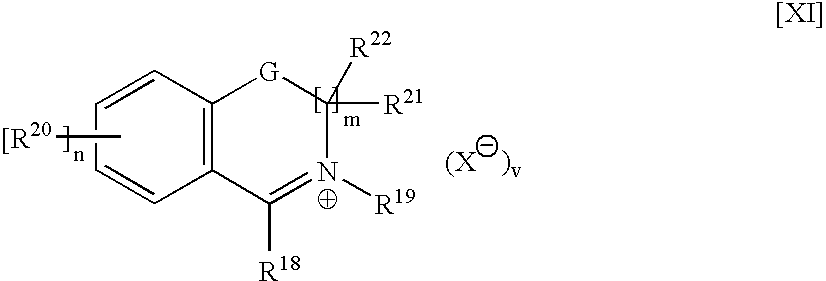Stable formulation components, compositions and laundry methods employing same
a technology of formulation components and compositions, applied in the field of formulation components, can solve the problems of lack of fabric color safety, limited effectiveness of oxygen bleaching agents, and tendency to be extremely temperature-dependent, and achieve the effect of improving the stability of organic catalysts and extending the catalyst li
- Summary
- Abstract
- Description
- Claims
- Application Information
AI Technical Summary
Benefits of technology
Problems solved by technology
Method used
Image
Examples
synthesis examples
Example I
Preparation of N-(1-cyclohexylethyl)-3,4-dihydroisoquinolinium tetraphenylborate (1)
[0292]
Typical procedure for the synthesis of dihydroisoquinolinium salts is as described in the art, as in Page, P. C B. et al. J. Org. Chem. 1998, 63, 2774. The parent amine used in this reaction was 1-cyclohexylethylamine.
example ii
Preparation of N-tert-butyl-3,4-dihydroisoquinolinium tetraphenylborate (2)
[0293]
Typical procedure for the synthesis of dihydroisoquinolinium salts is as described in the art, as in Page, P. C B. et. al. J. Org. Chem. 1998, 63, 2774. The parent amine used in this reaction was cyclohexanemethylamine.
example iii
Preparation of 3-(3,4-dihydroisoquinolinium)-butane-2-sulfate (6)
Step 1: Preparation of 3,4-dihydroisoquinoline (2) is as described in U.S. Pat. No. 5,576,282.
[0294]Step 2: Preparation of 2,3-butanediol cyclic sulfate (5):
[0295]A three-neck, 500 mL round bottom flask equipped with mechanical stirrer, pressure equalizing addition funnel, and reflux condenser with Drierite® filled drying tube is charged with 2,3-butanediol (4, 4.51 g, 50.0 mmol) and 50 mL of carbon tetrachloride. When the 2,3-butanediol is dissolved, thionyl chloride (5.5 mL, 75 mmol) is added dropwise at room temperature and the reaction is heated to approximately 60° C. After two hours, the reaction is slowly cooled to about 0° C. Deionized water (50 mL) and acetonitrile (75 mL) are added. Ruthenium chloride hydrate (0.13 g, 0.50 mmol) and sodium periodate (21.4 g, 100 mmol) are added and the reaction mixture is stirred at room temperature for 1 h. The mixture is extracted with diethyl ether (4×175 mL), the organic...
PUM
| Property | Measurement | Unit |
|---|---|---|
| temperatures | aaaaa | aaaaa |
| temperatures | aaaaa | aaaaa |
| temperatures | aaaaa | aaaaa |
Abstract
Description
Claims
Application Information
 Login to View More
Login to View More - R&D
- Intellectual Property
- Life Sciences
- Materials
- Tech Scout
- Unparalleled Data Quality
- Higher Quality Content
- 60% Fewer Hallucinations
Browse by: Latest US Patents, China's latest patents, Technical Efficacy Thesaurus, Application Domain, Technology Topic, Popular Technical Reports.
© 2025 PatSnap. All rights reserved.Legal|Privacy policy|Modern Slavery Act Transparency Statement|Sitemap|About US| Contact US: help@patsnap.com



